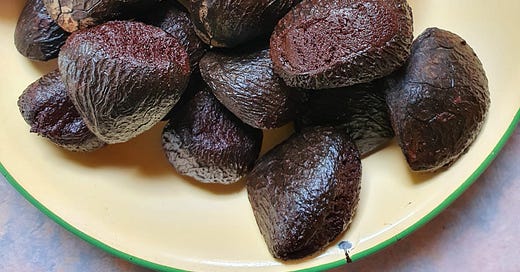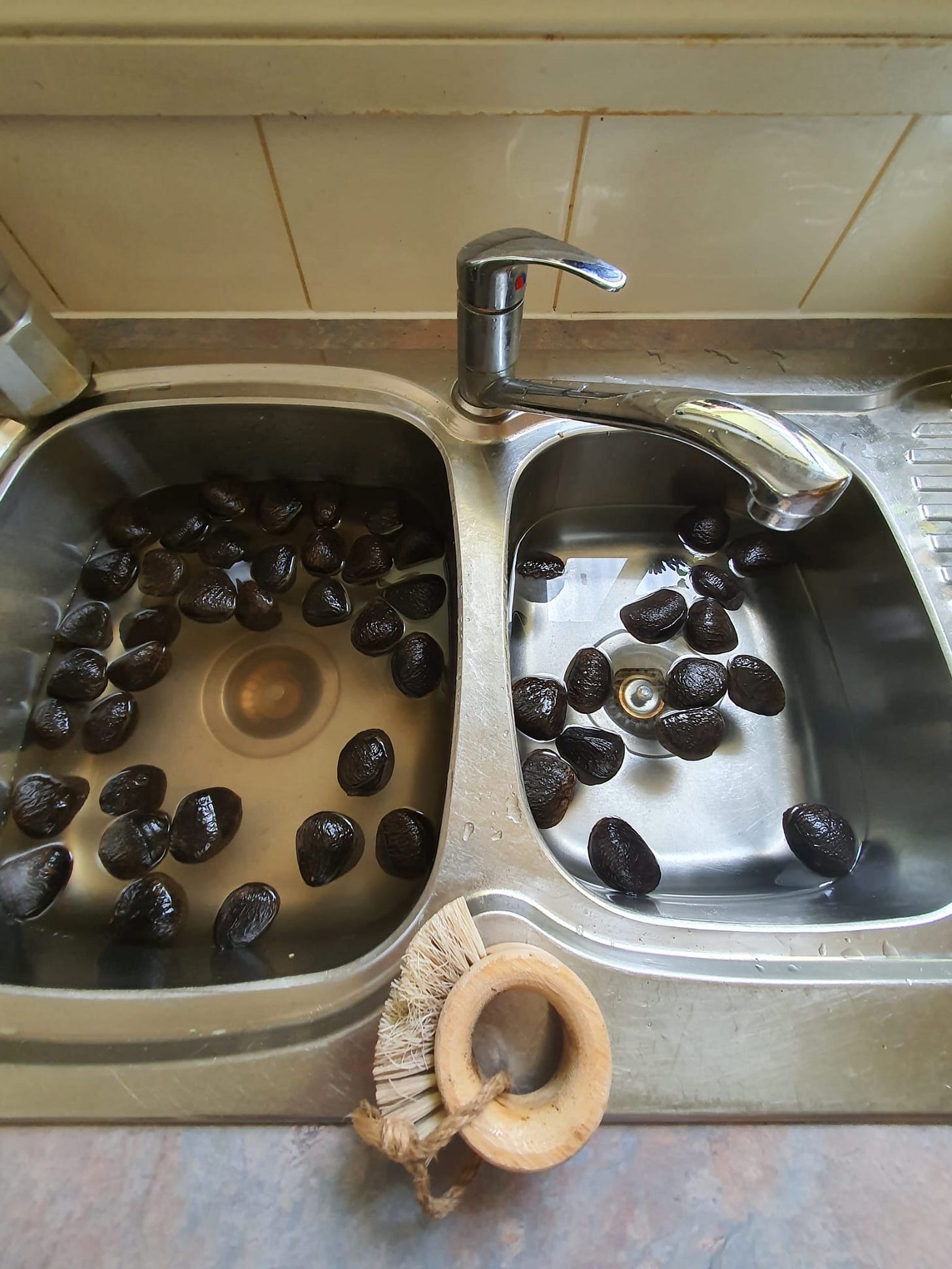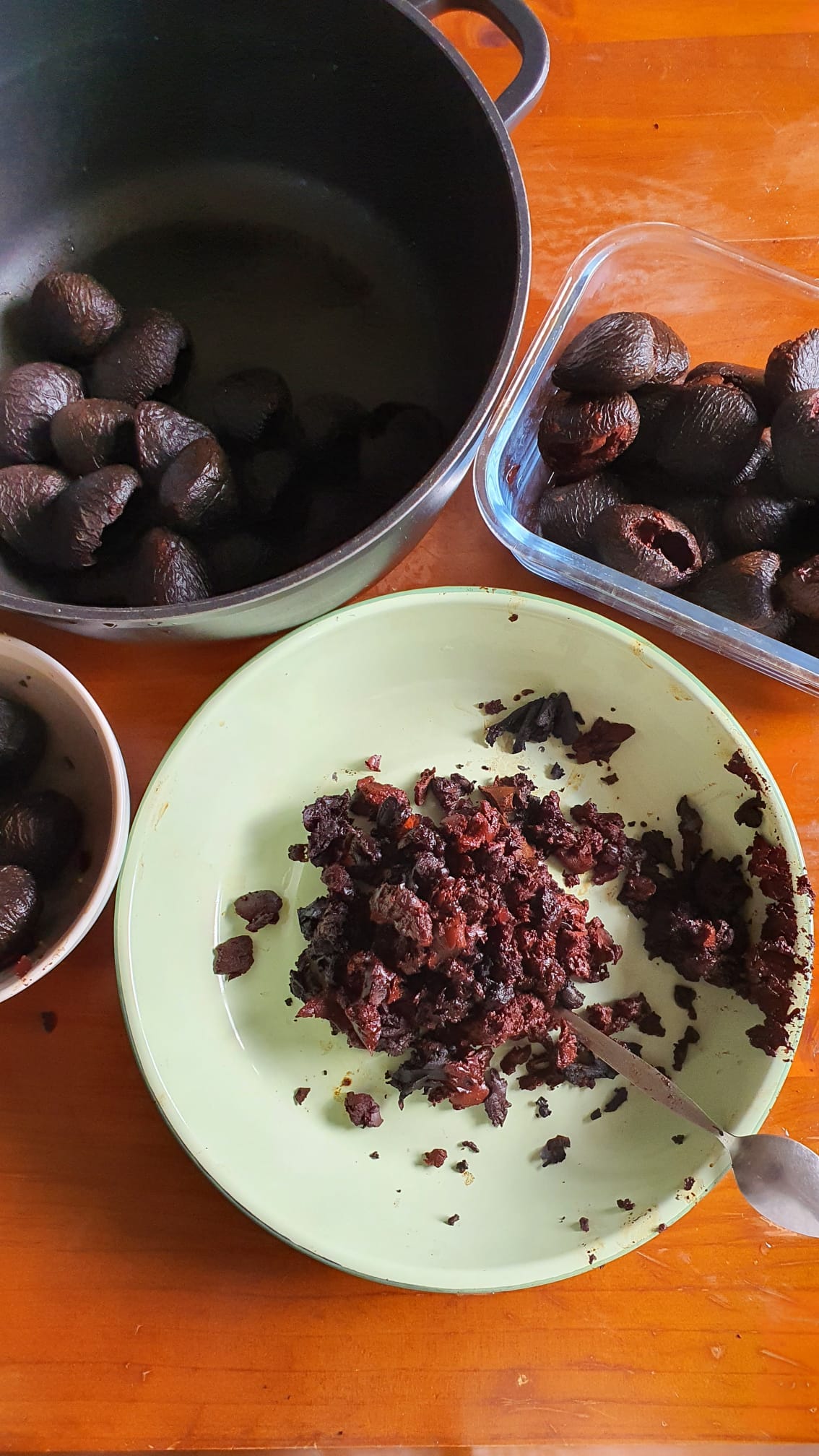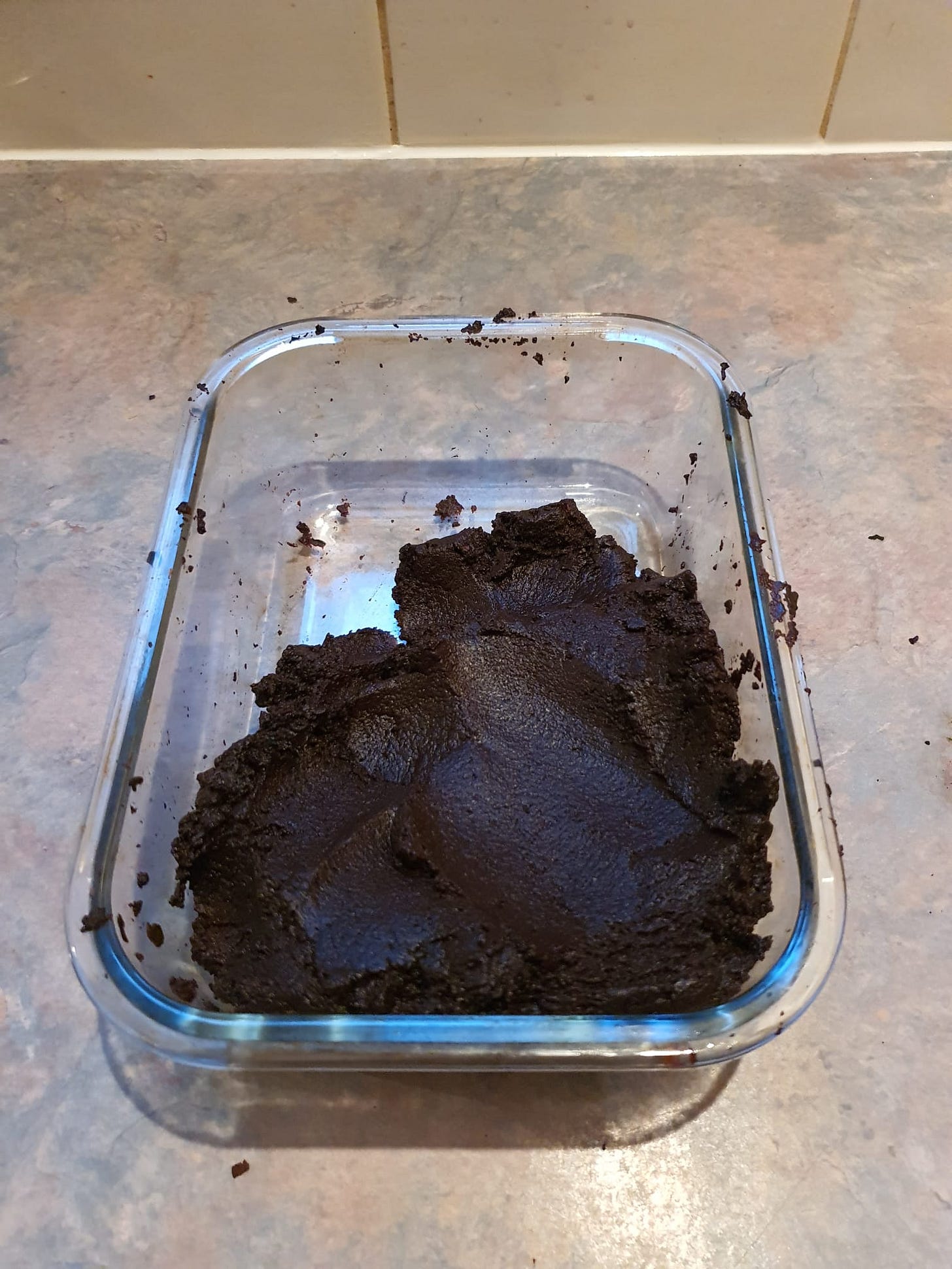One of the most articulate and passionate podcast interviewees I’ve listened to of late is Dan Saladino, speaking on the subject of food diversity and saving endangered foods. In his book Eating to Extinction, he shares stories of plants that have fed people for thousands of years, but which now are mostly forgotten.
When I was younger, I used to think that the world outside of Singapore - the worlds in these books I was reading about - was so distant from our reality, and that these anecdotes were good to know, but ultimately, irrelevant. It was only in recent years that it has become increasingly obvious that there are multiple parallels to be drawn. In the case of Saladino’s book, while most of us will never be able to access produce such as bear root, there are rare, wild ingredients in our part of the world to protect and cherish as well.
Take buah keluak, for example. This is the seed of the pangium edule tree, a species native to Indonesia and Malaysia, known fondly as the truffle of the East or black gold. While they are a prized delicacy in Singapore, the seeds fetch a low price in Indonesia’s markets, giving little incentive to the locals to cultivate it. Growing wild, the pangium trees are regarded as protectors for the villages they are in, for having existed for generations and for their excellent water-retention properties, safeguarding crops in the villages from drought.
When fruit falls from the tree, the villagers crack it open to expose the seeds within - what we know to be the nuts. As these are toxic when harvested, they have to be treated to render them safe for consumption. Villagers boil and bury them in ash for over a month, allowing the deadly cyanide compounds to break down, turning the creamy white nuts black in the process.
In some cases, this is ash from many of Indonesia’s volcanoes. In others, according to cookbook author Lloyd Matthew Tan who has spoken with the locals in Indonesia, the nuts are placed in a pit and covered with banana stems that are lit on fire. The process of burning lasts for a whole week before the nuts are buried in the ash.
By the time buah keluak arrives in Singapore, the nuts have already been processed, as evidenced by their black colour and their slightly smoky scent. However, to fully remove all remnants of cyanide compounds and volcanic ash, they have to be further processed in the home kitchen. Generations of Peranakans, Eurasians, and Indonesians alike have refined the art of purging the nuts over days and making full culinary use of the umami, oily flesh within.
After listening to Saladino’s interview and reading excerpts of his book, cooking this dish from start to finish was a moving experience for me. How wonderful and improbable is it for humans to discover ways to transform an entirely toxic nut into a delicacy? How many people died in that process of trial and error? What a gift it is to have the wisdom to cook buah keluak in my own kitchen from the knowledge refined by so many before me, skills that have allowed a people to find food and survive through their own resourcefulness.
I once read about nixtamalization, a traditional practice developed in Central America. While corn is certainly delicious on its own, the women soaked their corn grains in water with ash from the wood fires they were cooking with, loosening the tough hulls and making it easier to grind them into cornmeal for tortillas. The genius of this process was that the alkali from the ash was what unlocked nutrients and expanded the nutritional profile that the corn provided the indigenous people. When the Europeans moved to America, they were quick to integrate maize into their diet. However, dismissing the practice as primitive, they did not employ the indigenous American technique of nixtamalization, eventually resulting in widespread malnourishment and vitamin deficiencies.
When Singaporeans cease to continue the art of processing buah keluak, we are not just losing a range of traditional dishes. We are also at risk of losing indigenous skills that have come to form a part of our nation’s identity and food culture… skills that were proof of that fact that hard times were neither a barrier to creativity nor to eating well.
I hope that, by sharing everything that I know about preparing the buah keluak with you, you will be inspired to give it a go in your kitchen, and in the process, take hold of the food inheritance that we share.
As Saladino writes in his book, “Only a fool would risk losing these treasures.”
Buah Keluak (pangium edule)
Other names: buah kepayang, kluwek, kluwak. A misnomer for this nut in Singapore is ‘buah keras’, which means ‘candlenut’ - this confusion exists as some Chinese are not able to pronounce ‘r’.
Possible substitutes: The flavour of buah keluak is akin to pure cocoa, black olives, and wine. When added to a curry, it lends a deep bitter earthiness, the way dark chocolate adds depth to mole in Mexico. Texture-wise, buah keluak has oily flesh like black olives. There’s no substitute for it, as its texture and flavour are unique.
Availability: Buah keluak is available year-round. The most well-known stall to get it is Mr KK Seah’s stall at Tekka market (you’ll spot it by the bags of buah keluak hanging at the stall entrance), but some other markets such as Geylang Serai carry it at their dried goods sections. Indonesian grocers also sometimes sell the oily buah keluak paste without the shell, which works fantastically well (I’ve used it for rawon)! But for Peranakan dishes, you want to get whole nuts.
How to select: When selecting, feel the weight of the nut with your hands. A good nut should feel heavy for its size. When shaken, you should not be able to feel the contents rattling within the shell. If you can, it means that the kernel has shrivelled up and is less than fresh. Always buy more than the recipe asks for as there might be some that have gone bad. Mr Seah also tells me that there are two types of buah keluak - regular and bitter. It is all about personal preference. While bitterness sounds undesirable, I’ve tasted it and it is akin to bitterness in good durian, or dark chocolate. If you’re new to the nut, start with regular buah keluak. Most dried provision stalls do not offer both options, but Mr Seah does, as most of his shop is dedicated to the nut.
How to store: Buah keluak can be stored at room temperature, but for longer term storage, store in the refrigerator.
How to prepare:
1. Soak and scrub the nuts for three days, at least once daily (or twice daily if you are extra diligent). Change the water after each scrub. I would recommend soaking the nuts for no longer than five days as I’ve had the experience of nuts going bad after soaking for a full week. The soaking achieves two goals: purging the nuts of all grime and toxins, and softening the narrow smooth strip on the nut, known as the lip.
2. Using a heavy object such as the heel of a cleaver or pestle, crack the lip of the nuts carefully. There is a certain technique to this, I’ve noticed. The trick is to hold the nut lightly in your hand; if you grip too firmly, it cushions the impact of the blow and makes it harder to crack. Once cracked, pick out the shards of shell with your fingers. Another method is to gently pry open/crack the lip, then, with a pair of pliers, carefully remove the lip. (“Helps keep the fingernails clean!”, says a very helpful Nonya who left me a message.)
Matt of Perot Rumah says that if you struggle to crack the nuts open, it is a sign that the nuts are not soaked sufficiently and that the lip has not softened enough.
3. Scrape the flesh out of the nut with the back of a teaspoon. I’ve heard of some restaurants or communities using the cracked nuts as they are in their cooking, but for the most part, the flesh is removed from the nut. For this, the best tool, in my opinion, is the back of a teaspoon.
As you do this, it is imperative that you smell or nibble on the buah keluak flesh to check if they have gone bad in the process of soaking. Because each buah keluak is different, the flavours can range widely - just in one batch, I’ve had nuts that taste/smell like pure cocoa, wine, olives and truffles. Because of this, you have to rely on your intuition - does it smell or taste good to you? Nuts that are off will taste sour, smell plain bad, or fizz out of their shells when cracked. I like to go through the flesh with my fingers to feel for any bits of shell that might have escaped Step 2.
4. Smoothen the texture of the flesh by grinding and pushing it through a sieve. This is a step that many omit, but many families insist on it for the ultimate creamy buah keluak experience. With a blender, food processor, or pestle and mortar, grind the extracted buah keluak pulp until smooth. Then, push it through a sieve. What you should get is shiny, oily, utterly smooth black pulp.
At this point, the pulp is ready to be used in dishes such as rawon, where the pulp is blended into the rempah (spice paste). Gab of @gabdominic_kuehstry says that you can do the same if you’re making Peranakan-style buah keluak dishes if it is for self-consumption - there is no need to go through Step 5 if there is no one to present the dish to.
5. Season and stuff the pulp into the empty shells. Just as cocoa benefits from sweetness, sugar truly transforms the flavour of buah keluak. Season the pulp with salt and sugar to taste, then stuff it back into the empty shells. Some Peranakan families mix the pulp with minced meat, others don’t for an unadulterated buah keluak experience.
Gab says that the former option fixes the the buah keluak, and the gravy will not blacken as it cooks. This is why you would want to set aside some extra pulp for the gravy if going for this method. Gab also adds that if he is feeling lazy to stuff the filling into the shells, he would shape the mince and buah keluak mixture into meatballs and add them to the gravy.
Whichever you choose, you want to stuff the shells very generously, compacting them with your fingers or a teaspoon as you go. If they are less than completely full, the pulp might fall out of the shells in the cooking process.
Will write about the cooking of ayam buah keluak in the next newsletter! If you have further tips to add on the preparation of buah keluak, please leave a comment:









Help! My precious buah keluak nuts have started to get mouldy! Can I still consume them? I stored them in an airtight container since I bought them last month